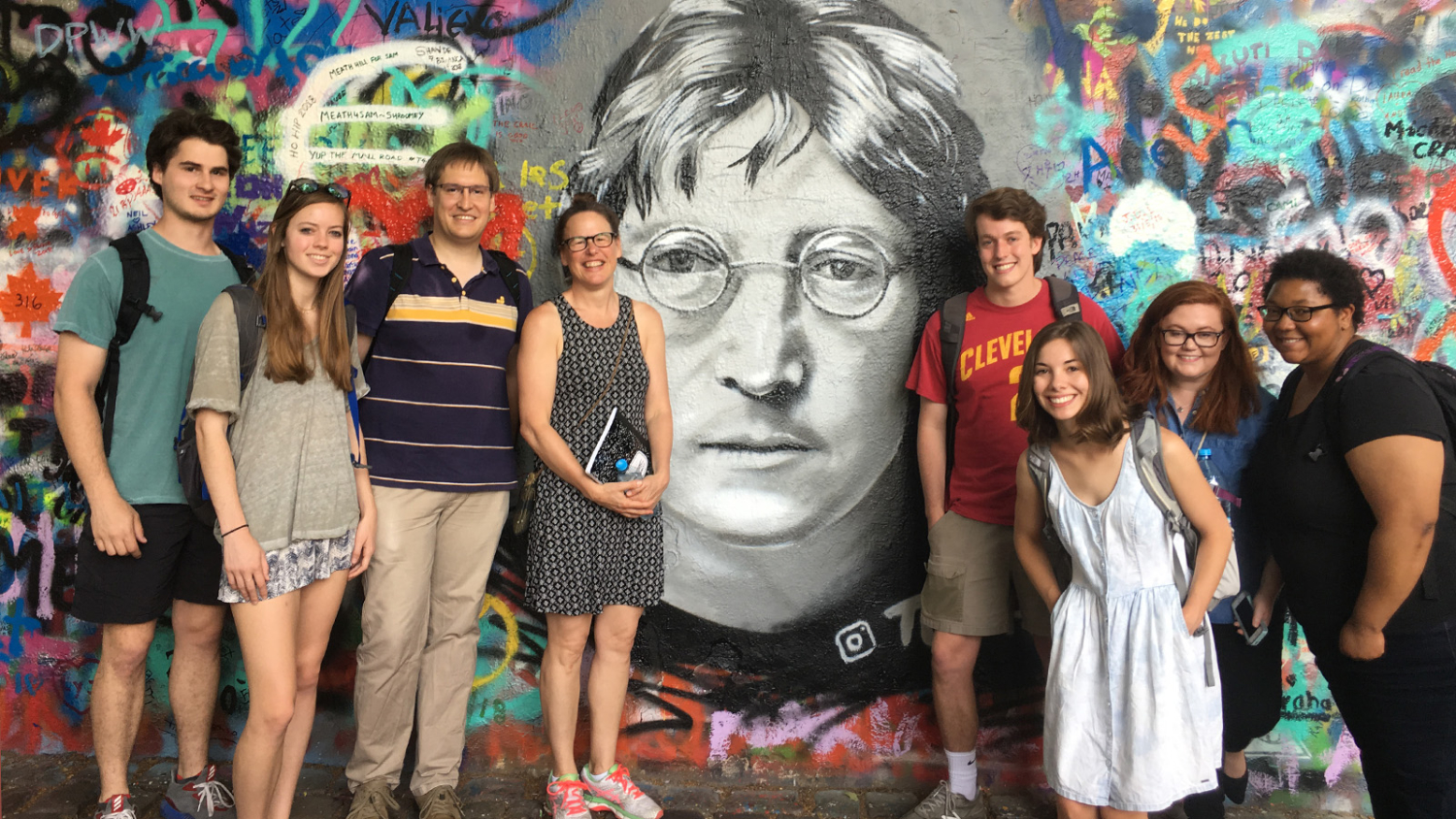With the city of Prague as their classroom, a group of NC State students experienced the power of public history.

During a two-week summer course in the Czech Republic, six students visited medieval monuments, a concentration camp and nearly a dozen other sites in and around the capital city. Students read about new sites each night, then visited them the next day. They studied how historians employ their expertise to enrich each site and also observed visitor interactions.
For their final project, students designed their own historical tours of the city. With themes ranging from Czech libraries to artwork by the sculptor David Černý, the tours offer a unique perspective of Prague.
History major Zoe Davis designed her tour around Prague’s Gothic architecture. Equipped with wayfinding and historical information, her tour includes stops at the city’s Powder Tower, Charles Bridge and Prague Castle.
“I thought the buildings with Gothic architecture were beautiful and like nothing I had seen before,” Davis says. “I also realized through our readings how important Gothic architecture is to the city.
“Prague remained mostly untouched by World War II; many of their original buildings are well preserved, unlike other cities in Europe.”
The class tailored its tours for visitors of NC State’s European Center in Prague. The center, a year-round international facility for NC State students and faculty, is the university’s hub for international networks and experiences.
Public History doctoral student Lisa Withers crafted her tour around the founding of Czechoslovakia in 1918. Stops include monuments and sites connected to the emergence of the new nation after World War I. For example, Prague’s Woodrow Wilson statue pays homage to the United States president’s advocacy for independent states following the war, a position that provided political support for creating the new Czech state.
“I was very intrigued by how Woodrow Wilson is a celebrated figure in Prague for his influence in founding the first Czech Republic (Czechoslovakia), particularly since Wilson does not have the same celebratory status in American historical memory,” Withers says. “Keeping in mind the audience would primarily be NC State undergraduate students, I wanted to create a tour that encouraged global thinking and awareness by situating the founding of Czechoslovakia within its international context and the turmoil of World War I.”
A ‘Highly-Mobile’ Classroom
This is the first year NC State offered Public History in Prague, a course co-taught by NC State history professor Tammy Gordon and Jaroslav Ira of Prague’s Charles University. The course included both undergraduate and graduate students in history, international studies and business.

Gordon says the group was “highly mobile,” with an itinerary that included stops at:
- Old Town Square, Wenceslas Square, the Jan Palach Memorial and the Charles University Rectorate.
- The Jewish Museum of Prague.
- Vitus Cathedral, Charles Bridge and Prague Castle.
- Mayrau Mining Museum.
- Terezin concentration camp.
- The Jan Palach Memorial, John Lennon Wall, and the Museum of Communism.
- Vitkov Hill.
Visiting sites like the Terezin concentration camp is a powerful learning experience for students, Gordon says.
“Public historians will have the responsibility of explaining histories that many people find difficult,” Gordon says. “In the American perspective, we will work to explain the enslavement of Africans, to explain lynching.
“So visiting a place like Terezin, where people have a very emotional reaction to that history, and having a public historian walk them through that history, is an experience they’ll be able to apply when they have the responsibility of teaching difficult histories in public history settings.”
As an NC State student, Davis says she has taken classes about World War II; however, visiting Terezin provided a more personal experience.
“This was my first time experiencing a place with that kind of deep and heavy history,” Davis says. “This just added a new layer to my understanding of World War II, and I am very grateful that this was a place I got to visit with the class.”
For Withers, the doctoral student, Terezin as well as the Lidice Memorial were also memorable visits. Reflecting on the trip, she says the alternative structure of the course provided unique opportunities for learning.
“I highly appreciated Dr. Gordon’s approach of using the city as the classroom, including visitor observation, and the opportunity to learn about museums and cultural heritage in another country,” Withers says. “These aspects of the course provided new ways to think about the relationship between an individual’s cultural and personal background and how that person may engage with the past, particularly in an international context.”

On the last day of the trip, students attended a symposium on the role of historians in public life. Held at the European Center, the symposium featured presentations and panels featuring both American and Czech scholars. Topics included “Historians Addressing Social Problems,” “Heritage Management,” and “Interventions in Local History.”
“Problem-based learning is important, particularly in the humanities,” Gordon says. “The assumption is that historical knowledge is abstract and solves abstract problems. That’s true, but it can also solve practical problems.
The students’ experience of researching the history of Prague and studying the contemporary relevance of that history can also enrich other people’s experience of that place. My students’ learning can have real effects on other people’s lives, because public history is an outward facing discipline.”
This post was originally published in College of Humanities and Social Sciences.
- Categories:



